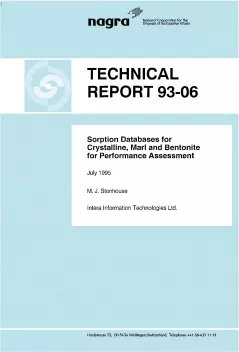
Technical Report NTB 93-06
Sorption Databases for Crystalline, Marl and Bentonite for Performance Assessment
In the repository for high-level waste (HLW), the waste containers are surrounded by a layer of compacted bentonite clay (reference bentonite MX-80). The crystalline basement of Northern Switzerland is being investigated as a potential host formation for the repository, while the planned repository for low- and intermediate-level waste (L/ILW) at the Wellenberg site will be located in Valanginian Marl. This report brings together, in dataset form, the sorption properties of the crystalline basement of Northern Switzerland, of the Valanginian Marl at Wellenberg and of compacted bentonite for safety-relevant radionuclides under repository conditions. These datasets are intended for direct use in safety assessments.
The heterogeneity of the crystalline basement and the Valanginian Marl in terms of sorption properties is documented in several datasets. For the crystalline basement, 13 different mineralogical compositions and two types of groundwater in the water-conducting features are distinguished. In the case of the Valanginian Marl, 5 different mineralogical compositions and two types of groundwater are distinguished.
Since sorption measurements for the different rock types occurring in the crystalline basement and the Valanginian Marl are somewhat lacking, reference was made primarily to sorption data for the individual rock-forming minerals. For these minerals, sorption measurements are available for the majority of the safety-relevant nuclides and are compiled in this report into comprehensive element-specific databases of distribution coefficients. The distribution coefficients for the different rock types are then derived from these data by adding together the distribution coefficients for the various rock-forming minerals according to their weight percentage in the rock.
For compacted bentonite, distribution coefficients from batch experiments and an extensive database of apparent diffusion coefficients measured for the reference bentonite MX-80 under repository-relevant conditions were taken into consideration.
The sorption datasets for the performance assessment contain a realistic and a conservative distribution coefficient (Kd-value) for each chemical element and rock type. The realistic Kd represents the best-estimate value for the rock type under the specified reference conditions for the solid and fluid phase; the conservative value represents the best estimate for the rock type in the case where unfavourable parameter values which deviate from the reference conditions are assumed for the solid and fluid phase. Redox conditions are an important parameter for redox-sensitive elements which can also deviate from the reference conditions. For many chemical elements, the pH of the fluid phase is decisive, while for others it is the presence of traces of specific solids.
The sorption datasets for the crystalline basement performance assessment and for compacted bentonite which are compiled in this report are compared with corresponding datasets from repository planners and operators in Finland, Sweden and Japan (bentonite only).
